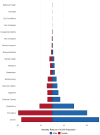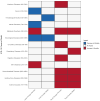The Unseen Aftermath: Associations Between the COVID-19 Pandemic and Shifts in Mortality Trends in Japan
- PMID: 39857527
- PMCID: PMC11765402
- DOI: 10.3390/ijerph22010074
The Unseen Aftermath: Associations Between the COVID-19 Pandemic and Shifts in Mortality Trends in Japan
Abstract
The COVID-19 pandemic disrupted healthcare systems globally, potentially altering mortality trends for non-COVID-19 diseases, particularly in aging populations like Japan's. Assessing these impacts is essential for responsive healthcare planning. We analyzed Japanese vital registration mortality records from January 2018 to December 2021 for adults aged 25 and older, excluding COVID-19-related deaths. Data were stratified by sex and ICD-10 cause-of-death chapters. Poisson regression models assessed changes in mortality rates and trends, incorporating pandemic-related variables and interactions between time, age group, and the pandemic term. Among the 4,920,942 deaths analyzed, 2,456,750 occurred during the pandemic years. Significant sex-specific changes in mortality trends were observed. Women experienced increases in mortality rates and trends for endocrine, nutritional, and metabolic diseases; skin and subcutaneous tissue diseases; circulatory diseases; and genitourinary diseases, reversing some pre-pandemic declines. Men showed increases in mortality trends for endocrine, nutritional, and metabolic diseases and genitourinary diseases but no significant changes for skin or circulatory diseases. These findings indicate that the pandemic differentially affected mortality trends between sexes, with women experiencing broader increases across multiple disease categories. The COVID-19 pandemic was associated with significant changes in mortality trends for certain non-COVID-19 diseases in Japan, with notable sex differences. Increased mortality among women across multiple disease categories highlights the pandemic's indirect health impacts and underscores the need for sex-specific healthcare strategies in the post-pandemic era.
Keywords: COVID-19; Japan; epidemiology; gender disparities; health policy; healthcare systems; mortality trends; non-communicable diseases; pandemic; public health.
Conflict of interest statement
The authors declare no conflicts of interest.
Figures



References
-
- Impact of the COVID-19 Pandemic on the Hospital and Outpatient Clinician Workforce: Challenges and Policy Responses. [(accessed on 23 November 2023)]; Available online: https://aspe.hhs.gov/reports/covid-19-health-care-workforce.
-
- Cunniff L., Alyanak E., Fix A., Novak M., Peterson M., Mevis K., Eiden A.L., Bhatti A. The Impact of the COVID-19 Pandemic on Vaccination Uptake in the United States and Strategies to Recover and Improve Vaccination Rates: A Review. Hum. Vaccin. Immunother. 2023;19:2246502. doi: 10.1080/21645515.2023.2246502. - DOI - PMC - PubMed
MeSH terms
Grants and funding
LinkOut - more resources
Full Text Sources
Medical

